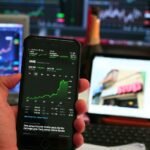Margin trading is a type of asset trading in which funds are provided by a third party.
Unlike standard trading accounts, margin trading allows traders to access larger amounts of money, allowing them to take advantage of their holdings.
Simply put, it amplifies trading results, allowing traders to make higher gains on successful trades.
Margin trading is extremely popular in low-volatility markets, such as the international Forex market, due to its ability to extend trading results.
It is also used in the stock, commodity and cryptocurrency markets.
Binance currently offers over 600 margin trading pairs, the best trading fees and high liquidity.
Get started on Binance here: https://www.binance.com/en/register?ref=73583477 or use “73583477” as your reference code.
Table of Contents:
1. The binance margin includes the crossed margin and the insulated margin. Which of the following sentences does not describe their difference?
Choices:
- In the isolated margin, the lending, trading and risk management functions are included in an independent isolated margin account, while in the cross margin, each user can only open one cross-margin account where lending, trading and risk management functions are available.
- They have different interest rates
- They have a different maximum leverage ratio
- Support different loans
Answer: They have different interest rates
2. The margin level is used to assess the risk level of your margin account. How is the margin level calculated?
Choices:
- Margin level = total value of assets/(total borrowed value + total value of accrued interest)
- Margin level = total value of assets/(total borrowed value – total value of accrued interest)
- Margin level = total borrowed value/ total value of accrued interest
Answer: Margin level = total value of assets /(total borrowed value + total value of accrued interest)
3. Which of the following events will force you to liquidate?
Choices:
- The margin level has reached the liquidation level
- The current margin level has reached the initial margin level
- Total debt is less than total interest
Answer: The margin level has reached the liquidation level
4. How often is margin interest calculated?
Choices:
- Every hour, at the time of the loan
- daily
- monthly
Answer: Every hour, at the time of lending
5. Do you need to borrow manually before trading?
Choices:
- Yes
- No, you can use the “auto loan” feature on the trading page.
Answer: No, you can use the “auto loan” feature on the trading page.
6. Which of the following factors does not affect the maximum loan limit?
Choices:
- The borrowing period
- The fund amount in your margin account
- Your VIP level
- The system’s lending limit
- Your individual loan limit
Answer: The loan period
7. Which of the following sentences is correct regarding the loan interest rate?
Choices:
- The interest rate of the loan will change with the market and the system will notify you when it changes
- The borrowing interest rate will be determined at the time of the loan, without changes thereafter
Answer: The interest rate of the loan will change with the market and the system will notify you when it changes
8. In case of liquidation, how to repay debts?
Choices:
- Binance Insurance Funds Will Cancel Your Debts
- You are required to repay debts yourself
Answer: Binance insurance funds will cancel your debts
9. How to pay interest fee with BNB in cross margin
Choices:
- Transfer BNB to cross margin account and refund manually
- Repay with the loan
Answer: Transfer BNB to cross margin account and refund manually
10. When you receive a margin call notification, what should you do?
Choices:
- Borrow more funds to hedge your risk
- Reduce your position to repay debt or add more collateral in your margin account
- Do nothing
Answer: Reduce your position to repay debt or add more collateral in your margin account
11. When trading on margin, a forced liquidation occurs when the margin risk ratio (total assets / total debts) reaches the liquidation risk ratio. Users are charged a “Liquidation Fee” in case of forced liquidation. Which of the following contains the correct description for liquidation settlement fees?
Choices:
- The liquidation fee is a fixed value for each liquidation.
- When the position is forcibly liquidated, the user will only be charged the fees of the liquidation orders, and you will not need to pay additional “Liquidation Liquidation Fees”.
- When the position is forcibly liquidated, a liquidation liquidation fee will be charged based on the amount of the liquidated assets. The system can use all remaining assets in the margin portfolio to complete the liquidation.
Answer: When the position is forcibly liquidated, a liquidation liquidation fee will be charged based on the amount of the liquidated assets. The system can use all remaining assets in the margin portfolio to complete the liquidation.
12. When the margin risk ratio (total assets/total debts) of your margin portfolio reaches the liquidation risk ratio, which of the following best describes what will happen?
Choices:
- When your margin portfolio is in liquidation, you will not be able to trade with this portfolio.
- The system will automatically sell your assets to repay your debts.
- You will be charged a liquidation fee based on the amount of liquidated assets.
- All of the above.
Answer: All of the above.
Conclusion
After completing the Binance Margin quiz, you will be able to start trading on Margin.
However, you need to get all the right questions to proceed.
You can use the Binance Margin quiz answers above to complete the quiz with a 100% pass rate.
There are 5 steps to margin trading, including choosing your account, transferring, lending, trading, and repaying.
Keep in mind that margin trading is very risky and you should only try it out if you know what you’re doing.


